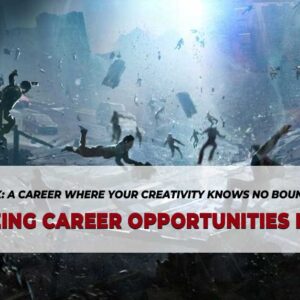
Login
X
- Home
- Courses
- Graduation
- Diploma Certificate
- Professional Diploma
- Special sessions / Aptitude boost up
- News & Events
- Student zone
- Placement
- Gallery
- FAQ
- Contact Us

VFX Industry
The art and craft of creating scenarios that cannot be effectively captured on camera using live-action and computer-generated (CG) sequences are known as visual effects (VFX). A career in VFX is undoubtedly gratifying and gives young people looking for such work prospects a sense of creative fulfillment.
Over the past few years, there has been a significant transformation in films and cartoons, including employing handcrafted and original items, a green screen, and visual effects to provide dramatic results. VFX has transformed the movie by creating a realism that is not physically feasible but appears natural. One of the global sectors with the fastest growth is visual effects (VFX). Graphic designers are quickly moving towards 3D modeling and animation, and the sector is expanding quickly and provides a wide range of opportunities.
Career opportunities
VFX has established itself as a mainstream field of labor, thanks to the film industry’s enormous international growth and the locally created production management division. An individual who wants to pursue VFX as a professional path must be proficient in various areas, including programming, technicality, and artistic methods. There are many career opportunities and options in the VFX industry, such as VFX editor, VFX artist, VFX animator, Texture artist, etc. In addition to these employment opportunities, this professional route offers considerable growth potential. Every industry uses visual effects, including games, film and drama television, post-production, animation, and more. CG and VFX careers are available in all of these fields.
Job Roles & Scope
The individual responsible for visual effects is known as a VFX artist. VFX artists work in a wide range of industries; they are not simply restricted to the movie industry. For instance, a gaming corporation depends heavily on these visual effects, and recently developed technologies like VFX and CGI are also crucial to the film industry. In addition, modelers, texture artists, previsualists, etc., use VFX. The word “visual effects,” sometimes known as “VFX,” refers to numerous studios. A VFX artist’s job is to use computer-based tools to produce animations and visual effects. To follow the storyline’s organized course, they develop a storyboard. With proper effort and education, a career in VFX will be impressive.
Love telling stories with pictures, videos, and sounds?
If you’re passionate about storytelling, visual arts, and technology, then a career in multimedia is the perfect fusion of your passions. With our comprehensive multimedia course, you’ll gain the skills and knowledge to become a sought-after professional in this ever-evolving industry.
Don’t let this opportunity pass you by. Enroll in our multimedia course today and start your journey towards a fulfilling and rewarding career in the exciting world of multimedia!
Visual communication that blends words, images, and ideas to convey information to the audience is known as graphic design. Visual communication and communication design are other names for graphic design. Graphic design career produce visual responses to your life.
The websites you browse, the commercials you see, the movies you watch, the games you play, and the packaging and logos of the goods you purchase are all the work of graphic designers. While it’s not always possible to teach someone how to have a good eye for design, most graphic designers have gone to art or design school to advance in their graphic design career.
Publishers, design firms, advertising agencies, and other industries that require skilled designers may also hire graphic designers. The majority of designers are able to complete post-graduate or bachelor’s degree programmes, which aid in their technical skill development and enable them to build portfolios of their work that can help them find jobs more quickly after graduation.
Many businesses, including those in advertising, printing, web design, etc., are in need of graphic designers. Tools like Photoshop, Gimp, Flash, Dreamweaver, Fireworks, Illustrator, Blend, and more should be familiar to new designers. But a designer’s career slows down a little after three to four years of experience. Designing requires more individual creativity than a collaborative effort. Improving your skills would greatly benefit your graphic design career.
The compensation of a designer becomes stagnant at a level of INR 4–5 lacs per year after gaining valuable professional expertise for about 6 years. However, with the development of the internet, there is a significant opportunity for freelance designing for numerous clients even when employed by a single organisation. On websites like Instagram, WordPress, Blogger, etc., you can also design, manage, and run your own campaigns to generate extra income from clicks, likes, and visitors.
In recent years, there have been an unprecedented number of graphic design courses. Graphic designers have a plethora of opportunities in the digital world.
You only need to select the educational programme that best matches your present design abilities and graphic design career growth objectives.
It may be necessary for you to enrol in numerous courses that cover various aspects of graphic design, including principles of graphic design, professional logo design, identity design, publishing design, managing digital design projects, and visual communication.
You can consider enrolling in courses that provide more in-depth instruction in the creative process and its practical application in graphic design once you have a basic understanding of design and have learned certain important design abilities.
Phone: 0495 272 2242